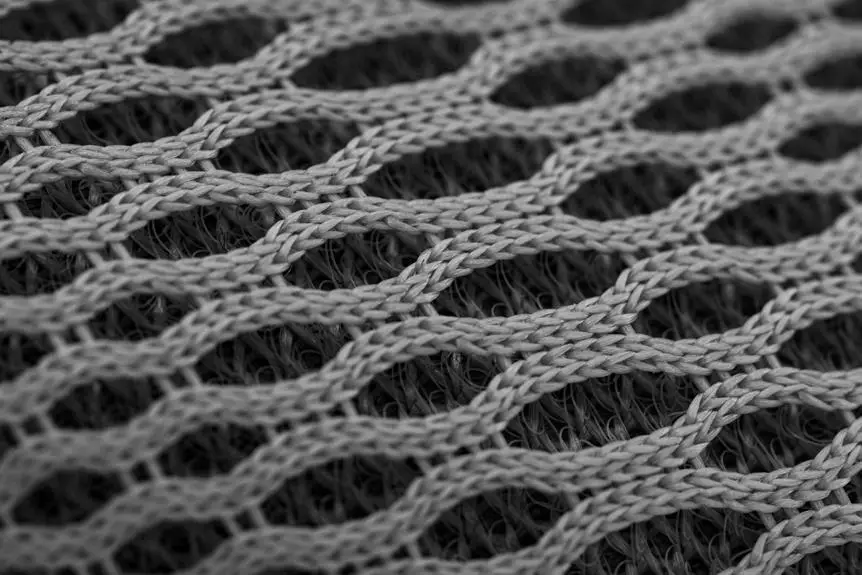When you're faced with the choice between fleece and flannel, it's important to think about what you value most in your fabric. Fleece provides warmth and moisture-wicking properties, making it great for outdoor activities, while flannel offers a soft, cozy feel perfect for relaxed settings. Each fabric has its own strengths, but how do you decide which suits your lifestyle best? Understanding the nuances of warmth, comfort, and versatility can help clarify your decision, but there's more to consider before making your final choice.
Table of Contents
Key Takeaways
- Activity Level: Choose fleece for active outdoor activities due to its superior insulation and moisture-wicking properties.
- Comfort Preference: Opt for flannel if you prefer a soft, textured feel for cozy lounging or casual outings.
- Breathability: Fleece may trap heat, while flannel allows better airflow, making it ideal for layering without overheating.
- Style Versatility: Fleece offers a sporty look, while flannel provides a rustic vibe; choose based on your style preference.
Overview of Fleece
Fleece, known for its softness and warmth, quickly became a popular choice for outdoor enthusiasts and casual wear alike. You'll appreciate its lightweight nature, which offers insulation without the bulk. This makes fleece ideal for layering, whether you're hiking in the mountains or just heading out for a stroll on a chilly day.
The fabric is made from synthetic fibers, typically polyester, which means it dries quickly and retains heat even when wet. If you're someone who enjoys active pursuits, you'll find fleece to be breathable, allowing moisture to escape while keeping you cozy.
Another advantage is its versatility. Fleece comes in various weights and styles, from thin pullovers to thicker jackets, accommodating different climates and activities. Plus, it's easy to care for—most fleece items are machine washable and resist wrinkling.
However, it's important to note that fleece can attract pet hair and lint, so you might want to consider this if you have furry friends. Overall, fleece offers a blend of comfort, functionality, and style that makes it a go-to fabric for many.
Overview of Flannel
Flannel is a cozy, woven fabric that's often chosen for its warmth and comfort, making it a favorite for both casual wear and lounging at home. Typically made from cotton or a cotton blend, flannel features a soft, brushed texture that feels great against your skin. You'll find it in various patterns and colors, perfect for expressing your personal style.
Here's a quick look at some key characteristics of flannel:
| Feature | Description |
|---|---|
| Texture | Soft, brushed feel that's gentle on skin |
| Patterns | Plaid, checkered, or solid options |
| Uses | Shirts, pajamas, blankets, and more |
Flannel's breathable nature makes it versatile, suitable for layering or wearing alone. It's easy to care for, too—most flannel items can be machine washed and dried without losing their softness. Whether you're snuggling on the couch or heading out for a casual outing, flannel offers the ideal blend of comfort and style. Once you try it, you'll see why so many people love this fabric for everyday wear.
Warmth and Insulation
When it comes to warmth and insulation, both fleece and flannel excel in keeping you cozy during colder months. However, they each have unique properties that can influence your choice depending on your needs.
Fleece is typically made from synthetic materials, offering superior insulation and moisture-wicking capabilities. This means it'll keep you warm even when you sweat. On the other hand, flannel, usually made from cotton or wool, provides a soft, breathable layer that retains heat effectively.
Here are a few points to consider when evaluating warmth and insulation:
- Fleece: It's lightweight yet offers excellent heat retention, making it ideal for active outdoor activities.
- Flannel: It's breathable, allowing for comfortable wear throughout the day without overheating.
Ultimately, your choice might depend on the specific activity you have in mind. If you're staying indoors or enjoying a leisurely day, flannel might be your go-to. But for outdoor adventures, fleece could be the better option.
Comfort and Softness
When it comes to comfort and softness, the texture of fleece and flannel can make a big difference in your experience.
You'll want to consider how each fabric retains warmth and their breathability factors for those cozy nights.
Let's explore how these materials stack up against each other in terms of feel and functionality.
Texture Comparison
Fleece offers a plush softness that wraps you in warmth, while flannel provides a cozy, brushed texture that feels gentle against the skin. When you're deciding between these two fabrics, comfort and softness play a crucial role. You'll want to consider how each material feels against your body during wear.
Here's a quick comparison of their textures:
- Fleece: This synthetic fabric is incredibly soft and lightweight. It's designed to feel luxurious, making it perfect for lounging around.
- Flannel: Made from cotton or a cotton blend, flannel has a slightly heavier feel but offers a comforting, brushed surface that can be soothing to touch.
Ultimately, your choice comes down to personal preference. If you lean toward a plush and lightweight feel, fleece is your go-to. If you favor a heavier, textured fabric that feels soft and breathable, flannel will likely be your best bet.
Warmth Retention
Both fleece and flannel excel in warmth retention, but they do so in different ways that can impact your overall comfort.
Fleece, made from synthetic fibers, traps heat effectively, creating a cozy layer that feels lightweight yet warm. Its plush texture offers a soft feel against your skin, making it perfect for chilly nights. You'll appreciate how quickly it warms up, ideal if you're heading outside or snuggling on the couch.
On the other hand, flannel, typically made from cotton or a cotton blend, provides a different kind of warmth. Its brushed surface creates a soft, inviting texture that feels great when you wrap yourself in it. While flannel may not trap heat as aggressively as fleece, its natural fibers are excellent at retaining warmth without overheating you. This balance helps you feel comfortable during various temperatures.
Ultimately, your choice depends on your personal preference for warmth and softness. If you want something lightweight and heat-retaining, fleece is your go-to. But if you prefer a soft, breathable option that still keeps you warm, flannel might be the better fit.
Breathability Factors
While you might prioritize warmth, breathability is equally important for comfort, and this is where fleece and flannel differ significantly. Fleece, made from synthetic fibers, tends to trap heat, making it less breathable. This can lead to overheating, especially if you're active or in a warmer environment.
On the other hand, flannel, crafted from cotton or wool, allows for better airflow, helping to regulate your body temperature effectively.
When considering breathability, think about these factors:
- Material Composition: Flannel's natural fibers promote airflow, while fleece's synthetic fibers can restrict it.
- Moisture Management: Flannel absorbs moisture without feeling damp, whereas fleece can retain moisture, leading to discomfort.
Ultimately, if comfort and breathability are your priorities, flannel is often the better choice, allowing you to enjoy warmth without sacrificing ventilation. Knowing how each fabric performs in terms of breathability can help you make the best decision for your needs.
Care and Maintenance
Caring for fleece and flannel requires different approaches to keep them looking their best and prolong their lifespan.
When it comes to fleece, you should always check the care label, as most fleece items are machine washable. Use cold water and a gentle cycle, and avoid fabric softeners, as they can reduce the fabric's breathability. For drying, tumble dry on low heat or lay flat to prevent pilling and maintain softness.
On the other hand, flannel is typically more durable but needs a bit more attention. Wash flannel in warm water to preserve its softness, and avoid bleach to prevent fading. It's best to dry flannel on a low heat setting or hang it to dry, as high heat can shrink the fabric.
Both materials should be stored in a cool, dry place to prevent mold and mildew. If you notice any pilling, use a fabric shaver carefully on fleece and flannel to keep them looking fresh.
Regular maintenance and proper care will ensure both fleece and flannel remain cozy and stylish for years to come, making your investment worthwhile.
Style and Versatility
Fleece and flannel not only offer comfort but also bring unique styles and versatility to your wardrobe. You can easily mix and match these fabrics with various outfits, whether you're dressing up for a casual day out or staying cozy at home. Fleece is often seen as sporty and functional, while flannel embodies a more rustic, laid-back vibe.
When considering how to incorporate these materials into your style, think about the following:
Layering: Fleece jackets work great over T-shirts or under heavier coats, while flannel shirts can be worn solo or layered over a tank.
Color and patterns: Fleece comes in a range of colors and prints, allowing you to express your personality, whereas flannel often features classic checks and plaids that add a timeless touch.
Occasions: Fleece is perfect for outdoor activities and workouts, while flannel easily transitions from casual outings to relaxed evenings at home.
Ultimately, whether you choose fleece or flannel, you'll find both fabrics enhance your wardrobe with their distinct styles and adaptability.
Frequently Asked Questions
Is Fleece Environmentally Friendly Compared to Flannel?
When considering environmental impact, you'll find fleece often made from recycled materials, while flannel typically uses cotton, which can involve pesticides. Yet, it's crucial to check specific brands' practices for a clearer comparison.
Can Fleece or Flannel Be Used for Outdoor Activities?
Absolutely! Fleece is lightweight and moisture-wicking, making it great for outdoor activities. Flannel offers warmth but might not handle sweat well. You'll want to choose based on your specific needs and conditions.
What Are the Allergy Considerations for Fleece Versus Flannel?
When considering allergies, you should note that fleece can sometimes trap dust and allergens, while flannel, made from natural fibers, may be less irritating. Always check for specific sensitivities before choosing your fabric.
Which Fabric Is Better for Sensitive Skin?
When considering fabric for sensitive skin, you'll want something soft and breathable. Fleece can irritate some, while flannel's natural fibers often provide comfort. Always test a small patch to see how your skin reacts.
How Do Fleece and Flannel Compare in Terms of Price?
When comparing prices, you'll find fleece is often cheaper than flannel. However, quality and brand can affect costs. It's worth shopping around to find the best deal that fits your budget and needs.
- Nonwoven Fabric Production Methods: A Visual Guide - July 11, 2025
- The Ultimate Guide to Nonwoven Polypropylene - July 11, 2025
- What Is the Difference Between a Nonwoven and a Knitted Fabric? - July 11, 2025






